Locating speckled trout in September can be difficult, so where should you begin fishing for them? In this guide, you will learn what speckled trout are doing this time of year and the key patterns that dictate their location.
Let's get started by describing the transition speckled trout are making in September.
Transitioning Speckled Trout in September
September is the time of year in Louisiana when speckled trout are nearly done spawning during the summer, but the fall pattern is not quite here.
This can make catching limits of speckled trout tough, because some begin transitioning from the "outside" of the marsh to the "inside".
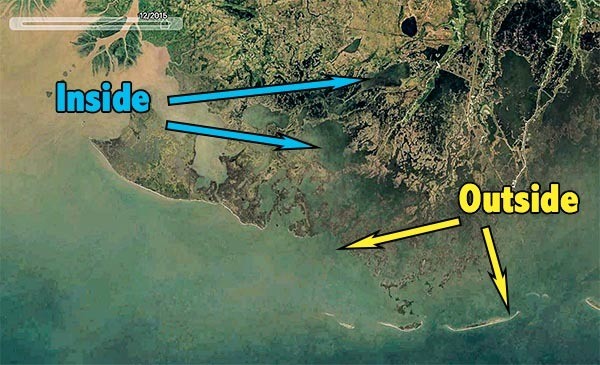
You will hear of other people in the industry describe this transition, but what they often leave out is that speckled trout don't all transition at once. Some come earlier while it's still warm in September, and others come inside later in October after a cold front or two has swept through.
So, you can fish places like the rigs and beaches of Grand Isle in September and catch speckled trout, but you can also chance across a bunch of them in places closer in, like Martello Castle in Lake Borgne.
This gives you a lot of options to work with. It certainly doesn't hurt to begin looking closer to the dock and avoid the longer runs into places like Breton Sound.
Be Ready To Cover Water & Remain Persistent
But, keep in mind the consequences of The Freshening. Louisiana's speckled trout are still recovering from ten years of record flooding, and this has put us in a "most water, least fish" scenario.
Should you choose to read my guide on most water + least fish, then you'll see that the key is to choose a productive area and be ready to cover water.
For example, in fall of 2023 the speckled trout action in Lake Pontchartrain was mostly non-existent. Traditional hot spots like The Trestles never really turned on. The trout just weren't there, but I did find them stacked up off the shore of Mandeville.
My point is that I did a lot of running and looking in order to find those fish, and you should be mentally prepared to do that as well.
This effort paid off, as I caught 90+ keeper speckled trout over the space of three days, by myself.
White Shrimp Are Key To Great September Speckled Trout Action
Those speckled trout I caught off Mandeville were eating white shrimp in a tidal highway. Those shrimp were their primary forage, which is a $10 word describing the thing that fish eat the most.
While speckled trout will eat pretty much anything that fits in their mouth, there are more white shrimp to gorge on than anything else.
Because these shrimp are found in specific places at specific times, they dictate when, where and how speckled trout feed.
If you finish this guide to completion, then you'll understand where to begin looking.
We begin by taking a look at why all these white shrimp are here in the first place.
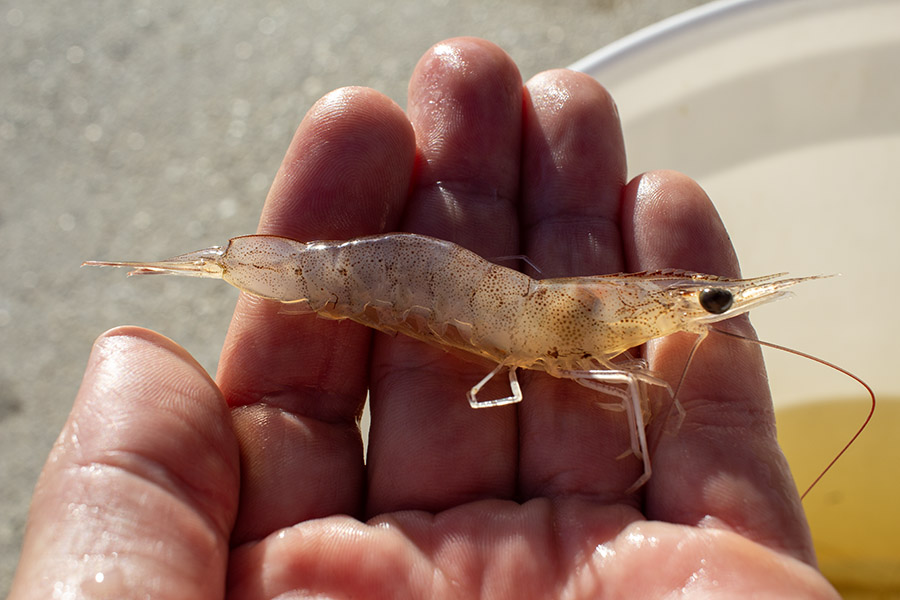
Why are there so many white shrimp for speckled trout to eat in September?
Let's gloss over the life cycle of white shrimp to answer this question:
- adults spawn in the Gulf of America
- fertilized eggs enter the marsh
- eggs hatch and shrimp larvae grow to sub-adults
- sub-adult leave the marsh to spawn in the Gulf
September is the time of year white shrimp begin migrating to spawn in saltier waters "outside" of the marsh. They will migrate through December and will be the primary forage speckled trout eat most. If you can figure out where these white shrimp are located, then you'll know where the speckled trout will most likely be.
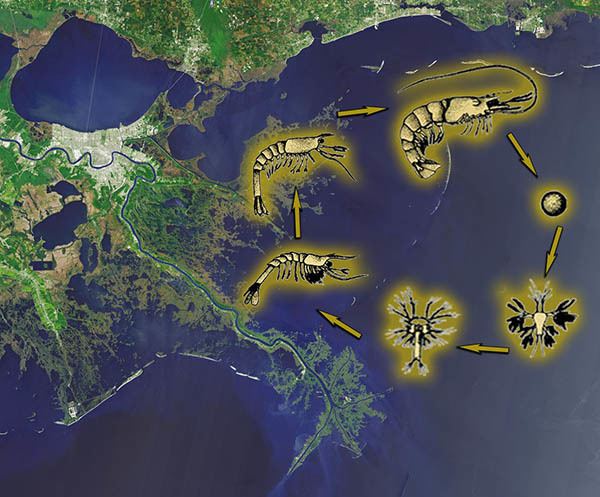
The best way to do this is by understanding how shrimp swim. How do they get from the inside to the outside?
Well, if you've ever seen a swimming shrimp, you know they are not powerful swimmers. Simply put, they can't cover as much water or resist current like a trout or dolphin does.
They'd wear themselves out if they tried, so instead they use the tide to take them out.
White shrimp will ride the tide to the Gulf of America like a conveyor belt. I personally feel that they have an instinct that lets them know when the tide is falling, so they swim up and out of the marsh. This process can take days or weeks.
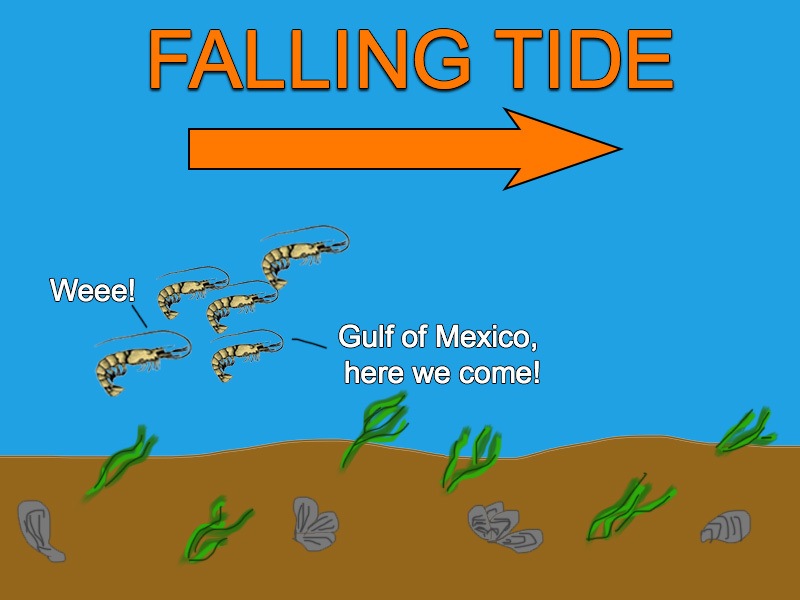
But if they were to freely swim with the tide when it's rising, then all they'd do is go back and forth. They wouldn't be very productive covering water.
So I believe (and could could be wrong) that most white shrimp have the sense to hunker down when the tide is rising, or incoming.
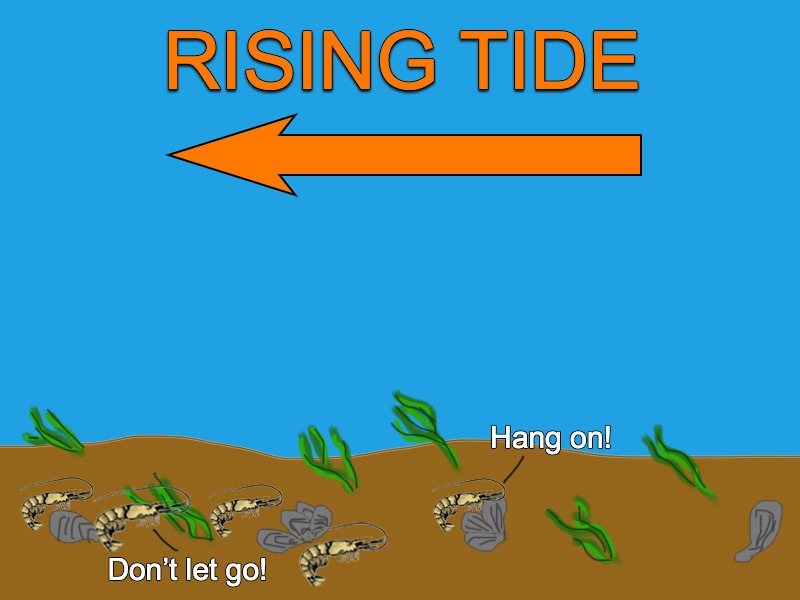
How is this behavior important for catching speckled trout in September?
Because when the tide is falling, they lift up and flow with the current, becoming vulnerable to predation by speckled trout.
When the tide is rising, they hunker down and even burrow into the seafloor, being much more difficult for trout to locate and eat.
Besides, speckled trout prefer ambush feeding, as described in this free fishing course. They prefer to sit in one spot and use that "conveyor belt" to eat white shrimp flowing to them, rather than run around the seafloor looking for errant shrimp to pick off.
Now You See That You Must Find Where These Shrimp Are Flowing
It's obvious by now that the white shrimp pattern is where you will find the speckled trout in September. It's predictable, visible and relatively easy to locate.
But, before you take off for the water, there are a few more things you should know to zero in on great speckled trout action.
Where & When To Find The Best Speckled Trout Spots In September
There's a couple more concepts to make all of this clear. The first to look is the best location for speckled trout feeding on white shrimp, then the timing.
Not All "Conveyor Belts" Are The Same Size
A trenasse, or small cut, will not yield as many white shrimp as say, a dominant bayou connecting a bunch of lagoons and ponds.
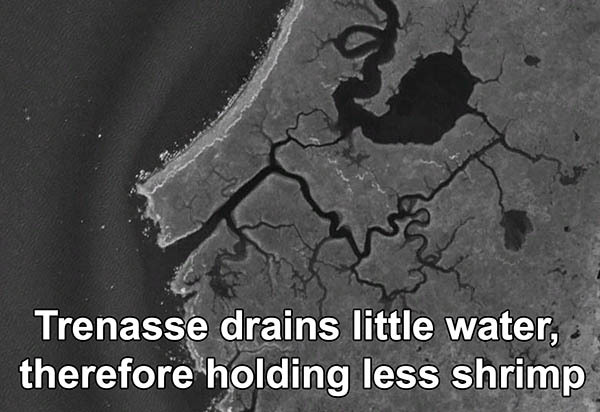
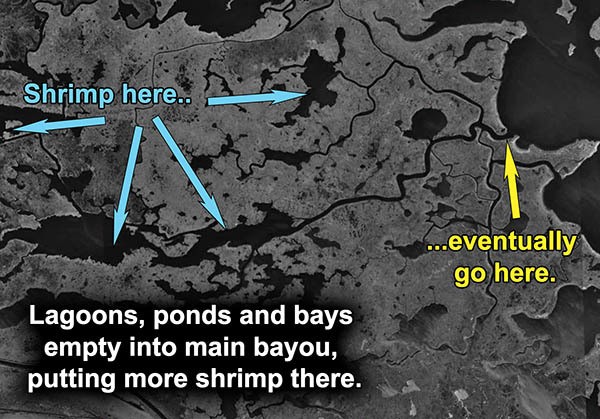
Taking it a step further, such a bayou will not transport as much water as a large pass.
If you're interested in more detail, then please look at my guide about Highway Theory.
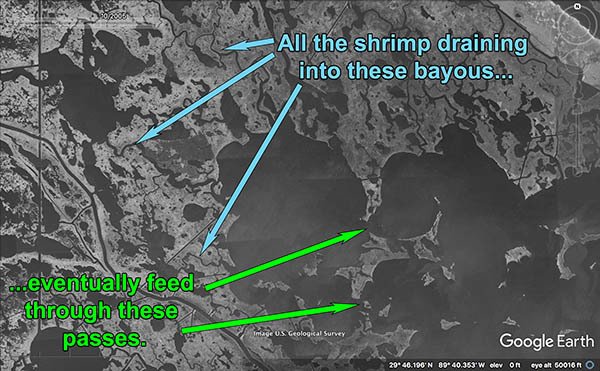
The Passes Will Move The Most White Shrimp
Because passes are downstream of the rest of the marsh — and because they are the ultimate "chokepoint" that all white shrimp must pass through in order to reach the Gulf of America — you will find the best speckled trout action there.
But there's more: passes tend to be deeper, because all the water moving through scours the bottom.
Because they're deeper and tend to have more moving water, they are cooler and oxygenated, being a great place for speckled trout to be comfortable.
They're really just the best places to catch speckled trout in September!
What are some examples of productive passes?
While there are many passes across Louisiana's coast you can fish for speckled trout in September, I will share a few examples so you have an idea as what to look for when you plan your next fishing trip.
Chef Pass Between Lakes Pontchartrain & Borgne
The Chef drains a whole lot of water, and you can expect to see diving birds at its mouth in Lake Borgne when shrimp really begin pumping through there.
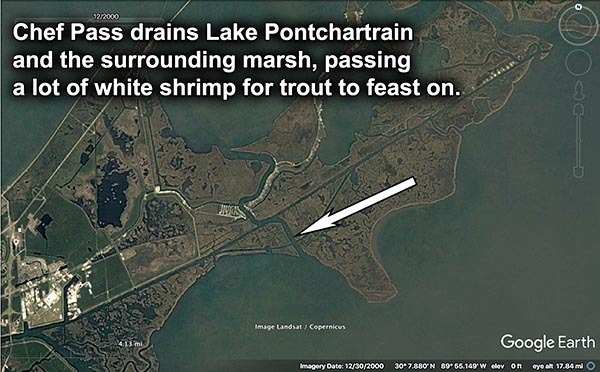
Crooked Bayou at Lake Eugene in Biloxi Marsh
Technically not a pass, I am still using this because the mouth is deep and it drains a lot of marsh. This is actually a good learning example.
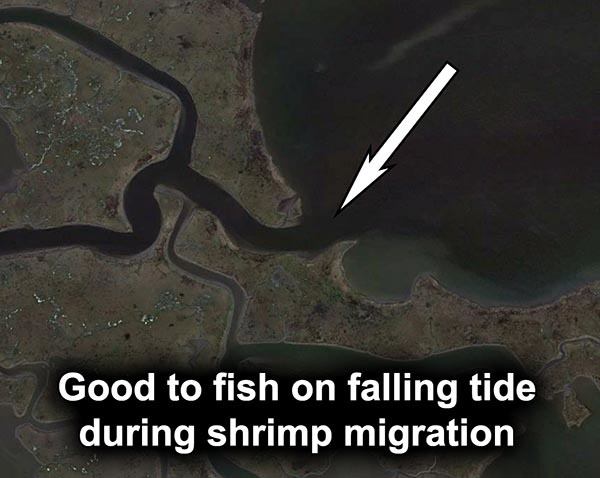
Then, after that, there's:
But those are only a handful of spots that are already well known by anyone with a fishing license. Trust me, they will fill up with boats and fishing pressure like any community honey hole.
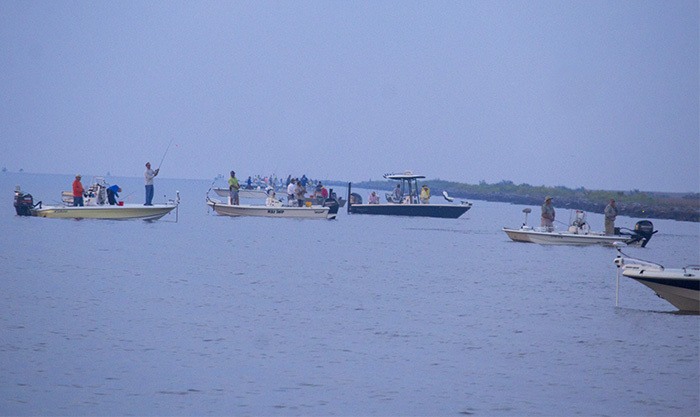
You can put up with this or find your own fishing spots.
There is a solution to avoid this, and that's to get out there when the time is right.
Most people (like you see in the picture above) wait for someone to hold their hand and tell them the speckled trout are biting at a particular spot.
These people are helpless, and if they had the fortitude to just try without being coddled then they would enjoy far more fishing success.
If you're here reading this, then I assume you have that fortitude. The next thing you need to know is when to begin trying these fishing spots for speckled trout in September.
The Best Time To Begin Fishing For Speckled Trout in September
Simply put, this is when the tide is falling.
Falling hard.
Falling its ass off.
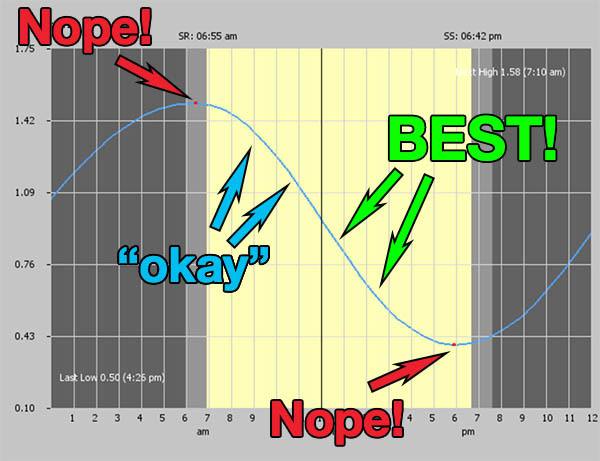
The reason why is because this is when the most white shrimp are going to be up and flowing with the current.
Speckled trout are not stupid. They know this, too. They will conserve their energy and wait for the target-rich environment to materialize before initiating their feeding frenzy.
This action is so predictable that I have planned entire YouTube videos around it and don't do it anymore because it's become boring and repetitive. That's how easy it can be to catch speckled trout in September.
But there's more besides this easy pattern!
You will have mornings where there is not a falling tide, but is instead rising. You will also have fishing spots that load up with speckled trout but don't have any white shrimp.
Where are these fishing spots? How should you fish them? How do you safely navigate to them and back?
Inside my course Inshore Fishing 101 I teach anglers how to find fish from scratch, keep their boat in safe water, select the best tackle and more.
Additionally, my follow-on course Fall Fish Location builds upon 101 to detail the specifics of fall fishing in Louisiana.
These courses and associated community are only available inside LAFB Elite.
An LAFB Elite membership is cheaper than learning it the hard way, and will help you catch fish more than anything in your boat.
“
Love The Humor & Wit
I have been fishing 45 years and haven't had much success. I would have quit a long time ago if not for my wife's and dad's love for it.
I very much enjoyed going through Inshore Fishing 101, love Devin's humor and wit, and learned a lot that I did not know.
“
Exactly What I Needed
Inshore Fishing 101 was absolutely amazing. It is exactly what I needed! That's because I was clueless to finding speckled trout, but this course was very eye opening on what needs to change in my game in order to find and catch them.
As a 17ft boat owner, as well as a kayak. The knowledge you provided in this course was worth every penny of the yearly subscription. Looking forward to Inshore Fishing 201 as well as the rest of the courses.

Thanks again for the information. Hopefully I can give it a try soon.
They are great seen them all. No change needed. Sorry
Juan, you’re not wrong, but white shrimp have been pushing out of the marsh since August.
People focus on the cold fronts because that’s the thing they see, kind of like cover that sticks out of the water for “bank beaters”.
Some of the best fall fishing you can do is right now, fishing a hard falling tide, especially the tail end of it.
Cold fronts play a part in that because they help drop water out of the marsh.
But if you’re waiting on a cold front to get onto good fishing then you’re going to miss a lot of great speckled trout action.
Devin what I have found along with what you have also said, shrimp really push out after a cold front. The wind is blowing hard out of the north pushing water. The water tends to be cloudy giving the shrimp some cover.